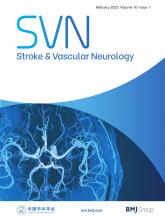Article Figures & Data
Tables
- Table 1
30-day risks following CEA and CAS in trials that randomised >500 recently symptomatic patients into EVA-3S, SPACE, International Carotid Stenting Study (ICSS) and CREST8 9 11 18
30-day risks EVA-3S8 SPACE9 ICSS11 CREST*18 CEA (n=262) CAS (n=261) CEA (n=589) CAS (n=607) CEA (n=857) CAS (n=853) CEA (n=653) CAS (n=668) Death 1.2% 0.8% 0.9% 1.0% 0.8% 2.3% Any stroke 3.5% 9.2% 6.2% 7.2% 4.1% 7.7% 3.2% 5.5% Death/any stroke 3.9% 9.6% 6.5% 7.4% 4.7% 8.5% 3.2% 6.0% Death/disabling stroke 1.5% 3.4% 3.8% 5.1% 3.2% 4% Death/stroke/MI 5.2% 8.5% 5.4% 6.7% Cranial nerve injury 7.7% 1.1% 5.3% 0.1% 5.1% 0.5% *Only includes symptomatic patients from CREST.
CAS, carotid artery stenting; CEA, carotid endarterectomy; CREST, Carotid Revascularisation versus Stenting Trial; EVA-3S, Endarterectomy Versus Angioplasty in Patients with Symptomatic Severe Carotid Stenosis; MI, myocardial infarction; SPACE, Stent-Protected Angioplasty versus Carotid Endarterectomy.
- Table 2
ORs (95% CIs) for 30-day death/stroke for CEA versus CAS in EVA-3S, SPACE, ICSS and CREST*
Trial OR (95% CI) EVA-3S8 0.38 (0.16 to 0.84) SPACE9 0.89 (0.55 to 1.42) ICSS11 0.53 (0.35 to 0.80) CREST*18 0.52 (0.29 to 0.92) Meta-analysis 0.59 (0.42 to 0.81) *Only symptomatic patients from CREST were included.
CAS, carotid artery stenting; CEA, carotid endarterectomy; CREST, Carotid Revascularisation versus Stenting Trial; EVA-3S, Endarterectomy Versus Angioplasty in Patients with Symptomatic Severe Carotid Stenosis; SPACE, Stent-Protected Angioplasty versus Carotid Endarterectomy.
- Table 3
2018 ESVS recommendations for managing patients with symptomatic carotid artery disease28
CEA is recommended in patients reporting carotid territory symptoms <6 months and who have a 70%–99% carotid stenosis, provided the documented procedural death/stroke rate is <6%. Class I Level A CEA should be considered in patients reporting carotid territory symptoms <6 months and who have a 50%–69% carotid stenosis, provided the documented procedural death/stroke rate is <6%. Class IIa Level A It is recommended that most patients who have suffered carotid territory symptoms <6 months and who are aged >70 years and who have 50%–99% stenoses should be treated by CEA, rather than by CAS. Class I Level A When revascularisation is indicated in patients who with carotid territory symptoms <6 months and who are aged <70 years, CAS may be considered an alternative to CEA, provided procedural death/stroke rates are <6%. Class IIb Level A When revascularisation is considered appropriate in symptomatic patients with 50%–99% stenoses, it is recommended that this be performed as soon as possible, preferably within 14 days of symptom onset. Class I Level A Patients who are to undergo revascularisation within the first 14 days after onset of symptoms should undergo CEA, rather than CAS. Class I Level A In recently symptomatic patients with 50%–99% stenoses and anatomical and/or medical comorbidities that are considered by the multidisciplinary team to make them ‘higher-risk for CEA, CAS should be considered as an alternative to endarterectomy, provided the documented procedural death/stroke rate is <6%. Class IIa Level B The colour of the text boxes identifies the class and level of evidence.
CAS, carotid artery stenting; CEA, carotid endarterectomy; CREST, Carotid Revascularisation versus Stenting Trial; ESVS, European Society for Vascular Surgery.
- Table 4
30-day morbidity and mortality in randomised trials comparing CEA and CAS in asymptomatic patients
30-day outcomes Lexington34 CREST-1*18 ACT-135 SPACE-233 Mannheim36 CEA n=42 CAS n=43 CEA n=587 CAS n=364 CEA n=364 CAS n=1089 CEA n=203 CAS n=197 BMT n=113 CEA n=68 CAS n=68 Death/stroke 0% 0% 1.4% 2.5% 1.7% 2.9% 2.0% 2.5% 0.0% 1.5% 2.9% Death/disabling stroke 0% 0% 0.3% 0.5% 0.6% 0.6% *Only asymptomatic patients in CREST-1 were included.
ACT-1, Asymptomatic Carotid Trial 1; CAS, carotid artery stenting; CEA, carotid endarterectomy; SPACE, Stent-Protected Angioplasty versus Carotid Endarterectomy.
- Table 5
2018 ESVS Guidelines: clinical/Imaging features associated with an increased risk of stroke in patients with asymptomatic carotid stenosis treated medically28
Clinical History of contralateral TIA or stroke CT/MRI ipsilateral ‘silent’ infarction Ultrasound Stenosis progression>20%; spontaneous embolisation on TCD; impaired cerebral vascular reserve; large volume plaques (>80 mm2); predominantly echolucent plaques; large juxta-luminal black area (>8 mm2) MRI Intraplaque haemorrhage ESVS, European Society for Vascular Surgery; TCD, transcranial Doppler ultrasound; TIA, transient ischaemic attack.
- Table 6
2018 ESVS recommendations for managing patients with asymptomatic carotid artery disease28
In ‘average surgical risk’ patients with an asymptomatic 60%–99% stenosis, CEA should be considered in the presence of 1+ imaging characteristics that may be associated with an increased risk of late ipsilateral stroke*, provided perioperative stroke/death rates are <3% and the patient’s life expectancy exceeds 5 years. Class IIa Level B In ‘average surgical risk’ patients with an asymptomatic 60%–99% stenosis in the presence of 1+ imaging characteristics that may be associated with an increased risk of late ipsilateral stroke*, CAS may be an alternative to CEA, provided perioperative stroke/death rates are <3% and the patient’s life expectancy exceeds 5 years. Class IIb Level B CAS may be considered in selected asymptomatic patients who have been deemed by the multidisciplinary team to be ‘high-risk for CEA’ and who have an asymptomatic 60%–99% stenosis in the presence of 1+ imaging characteristics that may be associated with an increased risk of late ipsilateral stroke*, provided procedural risks are <3% and the patient’s life expectancy exceeds 5 years. Class IIb Level B *See table 5 for clinical/imaging features.
The colour of the text boxes identifies the class and level of evidence.
CAS, carotid artery stenting; CEA, carotid endarterectomy; ESVS, European Society for Vascular Surgery.






